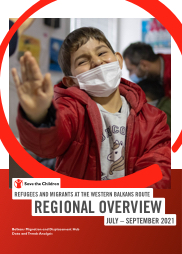
Briefs, Fact Sheets and Brochures
Balkans Migration and Displacement Hub Data and Trend Analysis: Regional Overview July-September 2021
Publication year:
2022
English
Format:
PDF (1.6 MiB)
Publisher:
Save the Children International,Save the Children North West Balkans
Data and Trend Analysis (DATA) Refugees and Migrants at the Western Balkans Route Regional Overview July-September 2021 describes key trends in migrations in the region, detailing information about the number of people on the move, demography (age, sex, country of origin, etc), behavioral patterns, and routes in use – with a focus on children, particularly unaccompanied children.
Key trends showcased in this report:
- The countries of Western Balkans saw the arrival of almost 50,000 refugees and migrants until the end of Q3 2021, with the largest numbers recorded in North Macedonia and Bosnia and Herzegovina.
- The most refugees and migrants in this period were from Syria, Afghanistan and Morocco.
- At the end of the reporting period, there were over 10,000 refugees and migrants in the Western Balkans countries, most of which were in Serbia (58%) and Bosnia and Herzegovina (35%). Serbia surpassed Bosnia and Herzegovina as the country with the most refugees and migrants present in its territory.
- Sea arrivals in Greece continued to be on a steady decline, with the majority of new arrivals detected in the Evros region of continental Greece. From there, a few options were available, either towards Italy (by boats or ferries) or through the Balkans route by crossing to Bulgaria, North Macedonia or Albania and continuing to Montenegro or Serbia. Romania remained one of the main exit points towards the EU countries, which is visible in a record number of asylum applications made in a single year.
- Collective expulsions, systemically used as deterrence measures and involving physical violence and abuse, continued to be documented at all borders throughout the region.
- Author: Nikolina Milic, Research and Data Analysis Coordinator
- Publisher: Save the Children in North West Balkans, Balkans Migration and Displacement Hub
- Region: Western Balkans, Europe
- Relevant global theme or subtheme: child protection, advocacy
- Keywords: Children on the move, Unaccompanied and separated children, Refugee children, migrations
Read full abstract
Authors
View & Download
Document information
Authors
Format
Content type
Country
Region
Topics
Rights
© Author/Publisher
Found a mistake? Help us improve!
If you have noticed a document assigned to the wrong author or any other inaccuracies, let us know! Your feedback helps us keep our data accurate and useful for everyone.
Share
Link

